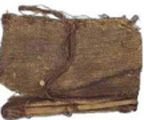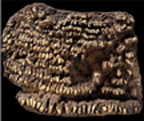|
|
CLOTHES - EGYPTIAN:The Ancient Egyptians costume, for the most part, was very simple and practical, consisting mainly of folded linen. And for over a period of three thousand years the changes in Egyptian clothing were minimal. Linens of various thickness were used to make clothing, the finest being a semi-transparent gossamer-like linen which was very much favoured by the Ancients. Men generally wore white linen wrap-over kilts, or skirts, that reached anywhere from thigh to ankle. They were usually rectangular in shape and tied at the waist. For the most part the men are usually shown bare-chested but sometimes they can be seen wearing a jerkin style top, most likely for warmth. The robe was another favourite of the Egyptian man. It came in various designs, but was generally long and flowing. The richer you were, obviously the more elaborate your clothing became. Pharaoh is often shown wearing a highly decorative and colourful kilt, plus a 'Khat', a linen headdress in blue and white stripes. Women's garments were mainly full length, starting from the shoulder and going down to the ankle. These dresses were worn, in particularly, by the noble and royal women of the court and were made from the lightest bleached-white linen. However temple dancers, acrobats, and workers often wore short kilts like
the men, or sometimes only thin strips of linen, or beads, tied around their waists.
On a more general note, wigs, jewellery, assessories, cosmetics and headdresses were used by both sexes.
Both sexes shaved their heads as well as their bodies for cleanliness, wigs were worn as decorative apparel a custom that went on for thousands of years. Egyptians loved to wear jewellery. Neck collars were very popular and made from clay beads, gold, glass and semi-precious stones. Peasant women also wore jewellery but obviously of lesser quality. The wearing of Amulets, usually in the form of their favourite gods and goddesses, was also very common.
The Ancient Egyotians also used pouches tided around their waist - the earliest form of the modern day handbag and not unsimilar to today's money-pouches. Ancient 'handbags' have been found in tombs and these sometimes had connective straps to make them easier to carry and free up their hands. The ancient Egyptians were masters of the art of weaving which allowed them to incorporate a wide range of artistic expression in terms of style, construction and decoration.
The bags would have been made from woven reeds, leaves and grasses or made from linen. Weaving is one of the worlds oldest forms of craftwork that is both practical and decorative. The wealthier you were the more decorative your bag was.


A couple of ancient handbags (shoulder strap and clutch) both totally recognisable as such, showing little has changed over thousands of years. Creams and oils were used to stop the ancient Egyptian's skin from drying out in the hot desert sun. Eyeshades and lip paints were made from different minerals. Favourite colours for eye makeup were green and black. Headdress came in all shapes and sizes but by far the most elaborate belonged to Pharaoh, although it would be more correct to describe these as crowns. OTHER ARTICLES River Nile in Ancient Egypt Ancient Egyptian Diet Egyptian Pharaohs - Women The Egyptian Cobra The Royal Harem Sensuality in Ancient Egypt Pyramids Facts Sphinx facts Mummy facts |